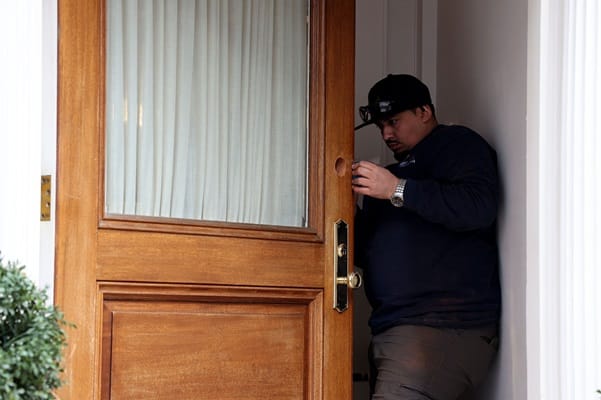Extreme weather events are happening more often, creating new challenges for security systems. Floods, hurricanes, and wildfires can damage locks and entryways, leaving homes and businesses vulnerable. In response, locksmiths are adapting. They are now designing locks that can handle these unpredictable forces, keeping properties secure in the face of climate change.
Locksmith services are evolving to meet these challenges. Professionals are using materials that resist saltwater corrosion and creating locks that can withstand harsh weather. What used to be the job of securing doors and windows is now about anticipating risks brought on by climate change and providing solutions to protect property.
The essential role of emergency locksmiths during disasters
When disasters strike, emergency locksmiths are often among the first to respond. Their work goes beyond repairing locks; they secure properties quickly to prevent looting and further damage. Following hurricanes, floods, or wildfires, locksmiths replace water-damaged locks and repair broken entryways, ensuring that buildings are protected against opportunistic theft.
Emergency locksmiths also play a proactive role by reinforcing security systems to prepare for future disasters. For example, in coastal areas prone to hurricanes, they install high-strength locks designed to withstand extreme wind and saltwater exposure. These measures help property owners recover from disasters while reducing the risk of future damage.
Adapting locks for extreme weather conditions
As climate change brings more severe weather, locksmiths are adjusting to meet new challenges. Traditional locks, often made of brass or aluminum, can rust or freeze when exposed to water. In flood-prone areas, locksmiths now use materials like stainless steel that are resistant to corrosion. Waterproof coatings are also being applied to locks for extra protection. In coastal regions, marine-grade locks, built to resist saltwater corrosion, are becoming standard.
High winds and extreme temperatures are also a concern. With hurricanes and storms becoming more frequent, locks need to be reinforced. In hurricane-prone areas, where wind speeds can reach over 150 mph, locksmiths are using reinforced materials like hardened steel. Weatherproof seals are also used to improve lock durability. In areas with extreme cold or heat, locksmiths design locks that won’t freeze or expand under extreme conditions.
Here’s how locksmiths are stepping up:
- Waterproofing Locks: Floods can render traditional locks useless. Emergency locksmiths now use waterproof materials and apply protective coatings to ensure locks remain operational even after water exposure.
- Saltwater-Resistant Solutions: Coastal regions face the added challenge of saltwater corrosion, which can severely damage locks. Emergency locksmiths use stainless steel or marine-grade materials to mitigate this issue.
- Reinforcement Against High Winds: In hurricane-prone areas, emergency locksmiths install reinforced locks made of hardened steel and use weatherproof seals to enhance durability.
- Temperature-Resistant Locks: Extreme heat or freezing temperatures can cause locks to malfunction. Emergency locksmiths now provide locks designed to resist expansion, contraction, or freezing.
Smart locks in a changing climate
Smart locks are becoming an integral part of emergency locksmith services due to their ability to function reliably under extreme conditions. These locks offer features like remote access, which allows property owners to secure buildings even if they cannot reach the site physically.
Emergency locksmiths often recommend weather-resistant smart locks with backup power systems. These systems ensure functionality during power outages—a common occurrence during storms. Such innovations provide property owners with added convenience and security, even in challenging environments.
The impact of saltwater and corrosion on locks
Saltwater corrosion is a major issue for locksmiths in coastal regions. The salty air speeds up the corrosion of metal parts, causing locks to seize or fail. Studies show that salt exposure can reduce a lock’s lifespan by as much as 30%. To address this, locksmiths are using materials like stainless steel and brass that resist salt and moisture better.
Locksmiths are also applying protective coatings like galvanizing to prevent saltwater damage. Special lubricants are used to reduce friction and avoid rust buildup. These extra measures help extend the life of locks, cutting down on the need for replacements. With the right materials and treatments, locksmiths can ensure locks continue to work even in coastal environments.
Preparing for future security challenges
As climate change brings more extreme weather, locksmiths are preparing for new security needs. They are turning to advanced materials, such as weather-resistant alloys and self-lubricating locks. These materials can withstand heat, moisture, and humidity more effectively. For example, titanium alloys are used in some locks because they resist corrosion and perform well in high temperatures, ensuring the locks remain functional even in severe conditions.
Sustainability is becoming a bigger priority as well. Many locksmiths are now using eco-friendly materials, like recycled metals, and designing energy-efficient smart locks. Some locksmiths are developing modular lock systems, which allow parts to be repaired or replaced without the need for a full replacement. This reduces waste and long-term costs, benefiting both the environment and consumers.
The role of emergency locksmiths in disaster recovery
Locksmiths play a critical role after extreme weather events. When storms or floods damage locks and doors, locksmiths are quick to restore security. After hurricanes or other disasters, locksmiths replace locks that were damaged by water or high winds. This helps protect properties from theft or further damage. Emergency locksmith services are essential during these times, providing immediate solutions to secure buildings.
Locksmiths also help strengthen properties to withstand future disasters. They recommend using weather-resistant materials and high-strength locks. In coastal areas, hurricane-resistant locks are now standard. These proactive measures help improve building security and reduce repair costs in the future. As extreme weather events become more frequent, locksmiths play a key role in both recovery and prevention.
Conclusion: The changing role of locksmiths
As the impacts of climate change continue to grow, locksmiths are adapting to meet new security challenges. Their job is no longer just about installing locks but also about creating systems that can withstand extreme weather. By using corrosion-resistant materials and weatherproof designs, locksmiths are making locks more durable and reliable. In the face of increasing climate risks, emergency locksmith services will play a vital role in restoring security after disasters. Locksmiths’ ability to innovate and provide resilient solutions ensures that properties remain safe, no matter the conditions.








